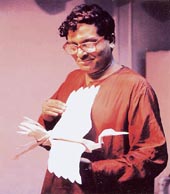 |
| Pramanik at work with his scissors. (Below) His work |
 |
The tool: a pair of scissors.
The product: an animation film.
All that the unconventional craft of paper-cutting animation requires is one basic tool and a skilled pair of hands. No computer, no graphics software, drawings or tracings ? only paper cuttings by an artist like Prabal Pramanik.
Born into the ancient tradition of Devasthanakala Sanjhi, Pramanik has dedicated himself to the preservation and growth of this dying art form of paper-cutting animation. During the times of Chaitanya Mahaprabhu, many Vaishnava temples and Nat Mandirs were decorated with silhouette and filigree paper-cut designs during festivals such as Raash, Dol, Janmashtami and Jhulan.
Now, Pramanik has reintroduced this rare form in the sphere of modern cinematography.
?Devotion, absolute faith in spiritual philosophy and extreme patience are required to practice and sustain this art. Generally, it takes a big team and a large budget to create an animation film, even if its is for a few minutes only. But our animation films are very different ? made with a limited budget and just three people (his wife Priya and associate Arup Chandra).?
Some of the notable short animation films made by Pramanik and Chandra have been The Mahabharata, Jayadeva?s Geetagovinda and The Life of Buddha.
Pramanik has had his work exhibited at many prestigious institutions such as the Sir John Cass Institute of Art and Technology, UK, Mus?e Guimet in France and the Benaras Hindu University. He has also created a complete 40 sq foot paper-cutting mural at Maison de l?Inde at Paris University. Zee TV, Doordarshan and the Alliance Francaise are some of the organisations, which have screened his work.
?All visuals of the animation movies,? says Chandra, ?were made without any drawing, and computers were used only for editing, lettering and music synchronisation.?
At present, he is busy building a museum in the village of Bhamlada, situated at the Himalayan foothills in Punjab. After experiments in various two-dimensional and three-dimensional forms, his scissors are busy giving new shape to the history of the paper-cutting art.

